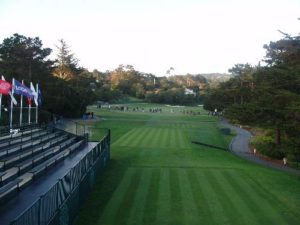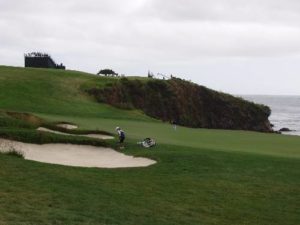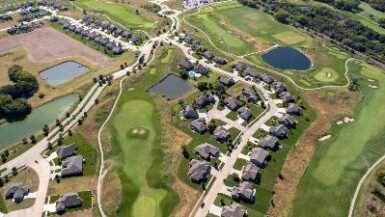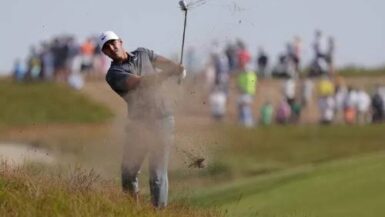
PEBBLE BEACH, CA – It’s called June Gloom, that cold, grey mist that descends upon Monterey Peninsula that turns the otherwise green and golden Pebble Beach into a scene out of Hound of the Baskervilles. Under this chilly blanket of clouds, it’s easier to understand how our beloved Pebble, perhaps the shortest of America’s informal rotation of national championship venues, can also turn out to be among the most difficult.
Pebble Beach is so much more than just gorgeous cliff-top golf holes with majestic views of the mighty Pacific. It’s the shrieking winds that blow golf balls to Hawaii and golf scores to the nether-reaches of the leader board. It’s tiny, but sharply-canted poa annua greens as slick as a parquet floor with macro and micro movement to befuddle even the most decorated champions. And it’s the deep, stiff, clingy kikuyu rough and ice plant that can grab a ball with the strength of a pit bull’s jaws and not let go until the player screams to the heavens in agony.
“The rough is definitely going to be a factor this week. We all know that. It’s very, very thick, very juicy,” stated two-time defending champion Brooks Koepka a favorite this week if the wind doesn’t confound him as it did on the back nine at Bethpage, where he nearly lost a brobdingnagian lead at last month’s PGA Championship. “You’ve got to put the ball in the fairways. Not many drivers here. I don’t need driver that much, maybe four times this week. But you need to put the ball in the fairway.”
Missing a fairway at any U.S. Open means a tall effort to get to the green, but at Pebble in particular, the species of native grass and other vegetation make it even more daunting.
“I think there’s going to be some very unlucky lies around the greens and the tops of the bunkers the way they’ve let the fescue, or whatever that grass is around the tops of the bunkers, grow. It’s quite a coarse grass as well. Any ball that lands just over the top of a bunker and lands in that longer grass, I think the ball is going to stick in there and you’re going to have some tough lies. And maybe you’ll see guys not move a ball possibly from the tops of those bunkers,” noted Justin Rose, the 2013 U.S. Open champion. “If you miss a fairway, it’s like dropping half a shot, but let’s see if you can, with a wedge in your hand, pick up that half a shot and make par and move on. It’s about not making doubles and triples in a U.S. Open. You can absorb a little hit. But you don’t want to have to be making two or three birdies to counteract a mistake, because the birdies are hard to find.”
Birdies will be harder still to find this year as, just like in 2010, the course will play to a par-71. The second hole, normally a par-5, is reduced to a par-4 despite its 516 yard length. Two is just one of several critical swing holes in the round, where a golfer can gain a stroke or two on the field or can shoot himself in the foot, perhaps even out of the tournament. No lead is safe at Pebble Beach, no lead is safe at a U.S. Open, and together they have the makings of a devastating synergy that can melt a golfer in their crucible. Let’s take a look at some of the more interesting and strategic holes that will help tell the come Sunday
No. 2, par-4, 516 yards
Two is really a par-4 and a half. Played as a par-5 from 1972 to 2000, if a player didn’t birdie two, he felt like he missed an opportunity. Now as a par-4, a par will likely earn a shot on half the field. In the 2010 Open, it played to a bloated 4.46 stroke average for the week, the second hardest hole on the golf course. That the USGA actually bothered to lengthen it from the 502 yards it played in ’10 may be a testament to a) the wind, b) the advances in equipment, c) the fitness of the players, or d) all of the above. But 516 yards? Really? That’s driver, 3-wood, wedge for us mere mortals.
“That’s really the only one on the front nine that I need to hit driver on,” explained Koepka who, like many other players, will eschew the driver in order to hit fairways and avoid the kikuyu.
No. 6, 523 yards, par-5

If a golf architect ever built a hole like number six today, you would hear the pros scream until their lungs bled. And then it would be bulldozed flat in the name of “fairness.” Happily, this year Pebble Beach is 100 years young, and it still shows how interesting quirks of golf architecture add character to a course.
One of the iconic shots in golf, the second shot ascends dizzyingly uphill, as if you’re hitting to a fairway suspended in mid-air. It must carry over the foaming surf of Stillwater Cove, and avoid both the beach and the greenside bunkers if the golfer is to have a putt for eagle. If ever a golf hole looked like it belonged on the cover of an album by prog rock band Yes, it would be six at Pebble.
In 2010 it played the easiest hole on the course and was one of only two holes that played below par by the field for the week. (The other was the 331-yard par-4 fourth.)

No. 7, 109 yards, par-3

“Seven stands out just for what it is. It’s great to play a par-3 that’s not 200 yards,” nodded an approving Justin Rose. “And I think as soon as the green gets firm, it’s like the 17th at Sawgrass. As soon as the conditions get a little bit rough, everything changes. It’s right there on the peninsula and on the rocks, and you get 10-15-mile-an-hour breeze, that green is pretty small. It’s an elevated tee, so the wind has more effect. It’s a fun hole.”
On Saturday, the par-3 7th hole at Pebble played a mere 99 yards, tied with number 10 at Inwood C.C. in 1923 for the shortest hole in U.S. Open history. And on Sunday, it claimed the record to itself, playing to a paltry 92 yards. Nevertheless, that same Sunday, that pint sized terror became a roaring Bonhamme Richard, playing to a staggering 3.22 stroke average: the 11th hardest hole on the golf course. It also played over par for the extent of the tournament (3.06 for the week.)
There was no wind that day. America’s proper rejoinder to Royal Troon’s famous “Postage Stamp,” Pebble’s seventh shows what smaller greens with sharp contours can do to a pro golfer’s score. Who needs 516-yard par-4s?
No. 10, 495 yards, par-4
When Tom Watson won the 1982 U.S. Open, Pebble Beach’s 10th hole played just 424 yards. Watson played a fade off the tee with a driver, and had a 155-yard 7-iron left to the hole.
Now the 10th is a full 70 yards longer, and where once there was a saving cut of rough, now drives that miss the fairway right end up on the beach with the sea lions. Worse still, the fairway slopes dramatically from left to right, toward the ocean. However, in a fascinating and brilliant architectural twist, the further you hit your drive, the more the fairway widens. It’s a great strategy decision: risk the penal ocean hazard for a shorter shot in from a better angle. The final hole on the “Cliffs of Doom” stretch, it may not be as picturesque or visually arresting as six or eight, it can confuse the golfer, leading to an unsure swing and a disastrous result.
The approach is equally fraught with peril. The front of the green is open, while bunkers surround the green from the 9:00 to 3:00 positions – the sides and the back. Short and right shots also risk landing in the long, thick, stiff kikuyu grass.
“It might even be a lost ball,” added 2010 champion Graeme McDowell, a look of fear and deep respect crossing his face.
Finally, the green has insidious micro-movement. “Putts look like they break right, but I knew from past experiences that they stay straight,” said Watson, who made such a putt to save a par there on Sunday in 1982.
There is some talk about possibly moving the tees up on this hole and a forward tee box at about 424 has been covered in mesh for possible use this week, but some of those meshed boxes are red herrings: they may or may not be used.
“If they have a tee box up there, I’ll probably hit iron if it’s off the front,” surmised Koepka, “But I have no idea. Wherever they set it up, I’ll just go play.”
No. 14, 580 yards, par-5
Normally, the par-5s are where a pro golfer wants to attack the course. Pebble Beach’s 14th is a notable exception to that rule. First, it dog-legs in an awkward place, making a sharp right turn after the tee shot. It hasn’t been lengthened much since Watson’s win in 1982 – it played 565 yards that year – but two deep bunkers guard the knee of the dog-leg, the lip of the further bunker being so high, that only players 5’10’ and taller can see over it to the fairway behind.
“Since I’m 5’9″ I have to jump to see it,” joked Watson.
Going for the green in two is nothing short of a leap of faith. It’s a tiny, severely elevated target with a ludicrously deep bunker guarding the front, a steep drop-off behind, and out of bounds on either side. If you go over, you’re playing back to a green sloping steeply away from you, and if you land short in the bunker, the ball tends to bury.
The smart play is a long-to-mid iron to 95-100 yards for a full sand or gap wedge in. Even that is dicey as only 40% as the contestants in the 2010 Open hit the green in regulation, a flabbergasting figure for the greatest players in the world, and a testament to how you don’t need gargantuan length to defend a par-5.
It was here in 1982 that Watson rolled in a double-breaking 35-foot birdie putt from the fringe that gave him, for a moment, the outright lead. (Nicklaus had birdied 15 ahead of him to claw into a tie.)
“That was THE putt that won the tournament for me,” (emphasis in Watson’s original article). “For the first time that day, the pressure wasn’t pushing me. It simply left, and I felt a great inner calm. I knew what I was trying to do and was doing it, and I was enjoying myself for the first time in the round.”
With only about 40% of the world’s greatest golfers able to hit it in three shots with a wedge in their hands, it played the hardest par-5 in 25 years.
No. 17, 208 yards, par-3

In 2010, the hardest hole for the week wasn’t a 500+ yard par-4 or a 600+ yard par-5, it was 17. For the week, less than 20% of the field hit the green in regulation. That’s a statistical outlier the likes of which we may never see again at any golf tournament for decades. 17 boasted a 3.49 stroke average for the week. Moreover,. With the exception of Tiger’s napalming the course in 2000, the 17th, drama queen to the nth degree has had a hand in deciding every U.S. Open.




